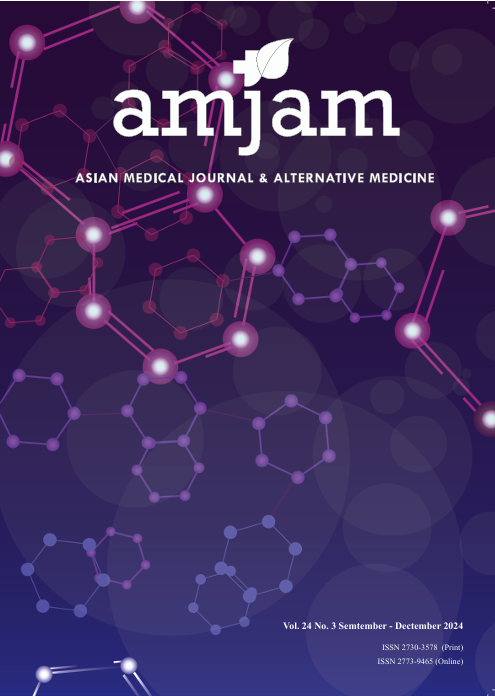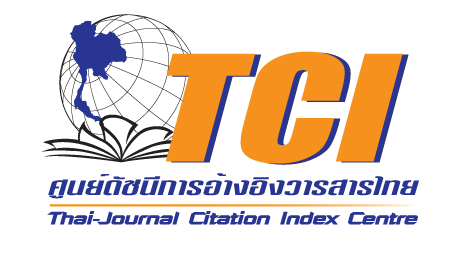Prevalence of Hematoma Expansion and Signs in Non-contrast Computed Tomography for Predicting Hematoma Expansion in Spontaneous Intracerebral Hemorrhage at Siriraj Hospital
Keywords:
Hematoma expansion, Prediction sign, NCCT HE predictors, Spontaneous ICHAbstract
Introduction: Hematoma expansion (HE) in intracerebral hemorrhage (ICH), defined by over 33% or > 6 ml volume increase, often leads to poor outcomes and mortality. This study aims to examine non-contrast computed tomography (NCCT) indicators for HE prediction and their associations with patient clinical data and HE occurrence.
Methods: We retrospectively analyzed data and measured HE by using image analysis software in NCCT images including initial and follow-up scan at <7 days from 169 patients during Jan 2013 - Aug 2019 in Siriraj Hospital.
Results: HE was found in 44 of the 169 patients with spontaneous ICH (26%), occurring in two periods: at 10–25 h (peak 7 h) and at 50–75 h (peak 50 h). Atrial Fibrillation (AF) and anticoagulant use were more prevalent in the HE group (15.9% and 20.5%) compared to the non-HE group (4.8% and 7.2%, p = 0.042 and p = 0.022). HE was linked to increased 60-day and 90-day mortality (29% and 32.3%, p = 0.016 and p = 0.010) and decreased time to follow-up scan (median = 21 h and 48 h). Satellite sign, heterogeneous density, intra-hematoma hypodensity, and fluid level prevalence were 46.2%, 35.5%, 21.9%, and 4.1%, but only heterogeneous density and intra-hematoma hypodensity were significantly associated with HE (p =0.003 and p =0.011), with heterogeneous density being an independent predictor (OR, 2.4; 95% CI, 1.2-5.1, p = 0.019) according to logistic regression analysis.
Conclusions: Heterogeneous density in NCCT is found as an independent predictor of HE among other significant HE-associated findings, which included heterogeneous density, intra-hematoma hypodensity, and various clinical data. Two peaks in expansion activity related to HE development were noted, a novel finding in this study, emphasizes the importance of delayed follow-up NCCT.
Downloads
References
Suwanwela N. Stroke Epidemiology in Thailand. Journal of Stroke. 2014;16(1):1-7.
Powers W, Rabinstein A, Ackerson T, Adeoye O, Bambakidis N, Becker K, et al. 2018 Guidelines for the Early Management of Patients With Acute Ischemic Stroke: A Guideline for Healthcare Professionals From the American Heart Association/American Stroke Association. Stroke. 2018;49(3):e46-e110.
Van Asch CJ, Luitse MJ, Rinkel GJ, van der Tweel I, Algra A, Klijn CJ. Incidence, case fatality, and functional outcome of intracerebral haemorrhage over time, according to age, sex, and ethnic origin: a systematic review and meta-analysis. Lancet Neurol. 2010;9:167-176. doi: 10.1016/S1474-4422(09)70340-0.
Davis SM, Broderick J, Hennerici M, Brun NC, Diringer MN, Mayer SA, et al. Recombinant Activated Factor VII Intracerebral Hemorrhage Trial Investigators: Hematoma growth is a determinant of mortality and poor outcome after intracerebral hemorrhage. Neurology. 2006;66:1175-1181. doi: 10.1212/01.wnl.0000208408.98482.99.
Dowlatshahi D, Demchuk A, Flaherty M, Ali M, Lyden P, Smith E. Defining hematoma expansion in intracerebral hemorrhage: Relationship with patient outcomes. Neurology. 2011;76(14):1238-1244.
Morotti A, Dowlatshahi D, Boulouis G, Al Ajlan F, Demchuk A, Aviv R, et al. Predicting Intracerebral Hemorrhage Expansion With Noncontrast Computed Tomography: The BAT Score. Stroke. 2018;49(9).
Law Z, Ali A, Krishnan K, Bischoff A, Appleton J, Scutt P, et al. Noncontrast Computed Tomography Signs as Predictors of Hematoma Expansion, Clinical Outcome, and Response to Tranexamic Acid in Acute Intracerebral Hemorrhage. Stroke. 2020;51(1):121-128.
Wada R, Aviv R, Fox A, Sahlas D, Gladstone D, Tomlinson G, et al. CT Angiography “Spot Sign” Predicts Hematoma Expansion in Acute Intracerebral Hemorrhage. Stroke. 2007;38(4):1257-1262.
Shimoda Y, Ohtomo S, Arai H, Okada K, Tominaga T. Satellite Sign: A Poor Outcome Predictor in Intracerebral Hemorrhage. Cere brovascular Diseases. 2017;44(3-4):105-112.
Barras C, Tress B, Christensen S, MacGregor L, Collins M, Desmond P, et al. Density and Shape as CT Predictors of Intracerebral Hemorrhage Growth. Stroke. 2009;40(4):13251331.
Blacquiere D, Demchuk A, Al-Hazzaa M, Deshpande A, Petrcich W, Aviv R, et al. Intracerebral Hematoma Morphologic Appearance on Noncontrast Computed Tomography Predicts Significant Hematoma Expansion. Stroke. 2015;46(11):3111-3116.
Ng D, Churilov L, Mitchell P, Dowling R, Yan B. The CT Swirl Sign Is Associated with Hematoma Expansion in Intracerebral Hemorrhage. American Journal of Neuroradiology. 2017;39(2):232-237.
Ovesen C, Christensen A, Krieger D, Rosenbaum S, Havsteen I, Christensen H. Time Course of Early Postadmission Hematoma Expansion in Spontaneous Intracerebral Hemorrhage. Stroke. 2014;45(4):994-999.
Tanaka K, Toyoda K. Clinical Strategies Against Early Hematoma Expansion Following Intracerebral Hemorrhage. Front Neurosci. 2021;15:677744.
Zhang D, Chen J, Xue Q, Du B, Li Y, Chen T, et al. Heterogeneity Signs on Noncontrast Computed Tomography Predict Hematoma Expansion after Intracerebral Hemorrhage: A Meta-Analysis. BioMed Research International. 2018;2018:1-9.
New P, Aronow S. Attenuation Measurements of Whole Blood and Blood Fractions in Computed Tomography. Radiology. 1976;121(3):635-640.
Songsaeng D, Peuksiripibul W, Wasinrat J, Boonma C, Wongjaroenkit P. Potential of Satellite Sign for Prediction of Hematoma Expansion in Small Spontaneous Hematoma within 7 Days’ Follow-Up. Asian J Neurosurg. 2023;18(1):45-52. doi: 10.1055/s-00431764327.
Yogendrakumar V, Ramsay T, Fergusson DA, et al. Redefining Hematoma Expansion With the Inclusion of Intraventricular Hemorrhage Growth. Stroke. 2020;51(4):1120-1127.
Maas MB, Nemeth AJ, Rosenberg NF, Kosteva AR, Prabhakaran S, Naidech AM. Delayed intraventricular hemorrhage is common and worsens outcomes in intracerebral hemorrhage. Neurology. 2013;80:1295-1299.
Witsch J, Bruce E, Meyers E, Velazquez A, Schmidt JM, Suwatcharangkoon S, et al. Intraventricular hemorrhage expansion in patients with spontaneous intracerebral hemorrhage. Neurology. 2015;84:989-994.
Dowlatshahi D, Deshpande A, Aviv RI, Rodriguez-Luna D, Molina CA, Blas YS, et al. PREDICT ICH CTA Study Group. Do intracerebral hemorrhage nonexpanders actually expand into the ventricular space? Stroke. 2018; 49:201-203.
Ducroux C, Nehme A, Rioux B, et al. NCCT Markers of Intracerebral Hemorrhage Expansion Using Revised Criteria: An External Validation of Their Predictive Accuracy. AJNR Am J Neuroradiol. 2023;44(6):658-664.
Downloads
Published
How to Cite
Issue
Section
License
Copyright (c) 2024 Asian Medical Journal and Alternative Medicine

This work is licensed under a Creative Commons Attribution-NonCommercial-NoDerivatives 4.0 International License.



